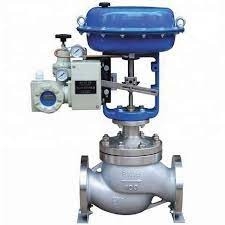GALLERY
PRODUCT DESCRIPTION
Pneumatic Actuator Globe control valve
A Pneumatic actuator mainly consists of a piston or a diaphragm which develops the motive power. It keeps the air in the upper portion of the cylinder, allowing air pressure to force the diaphragm or piston to move the valve stem or rotate the valve control element.
1. Concepts:
Pneumatic Globe Control Valve is a type of valve that allows precise control of flow rate and speed in the system. The pneumatic actuators on these valves use feedback and control signals to precisely open and close the valve.
2. Structure:
The structure of the globe control valve consists of two main parts, the pneumatic actuator and the globe valve. There are also other equipments such as: Pneumatic valve positioner, pneumatic solenoid valve…
Globe valve body
The body of the globe valve is the part that is in direct contact with the main pressurized fluid and is the place where all the valve details are stored. The valve body is usually a two-port type that can be oriented directly opposite each other or anywhere on the body, or together form a 90° angle (angle globe valve).
Globe valves are mainly used for corrosive, high temperature and high pressure viscous fluids. If the globe valve is installed on a horizontal pipe, there will be residual liquid in the valve body that will clog or corrode the valve body if the valve is not used for a long time. To avoid this situation, we can use angle or oblique globe valves. The valve body is usually made from force & heat-resistant alloys such as cast iron, stainless steel, steel…
Pneumatic actuator
Pneumatic actuators for globe valves typically come in two forms: piston and diaphragm. Unlike the actuators for ball valves and butterfly valves, which use a rotary motion, the globe valve uses sliding motion.
Piston-type pneumatic actuator
Structured and operated like a pneumatic cylinder, including a piston that moves in a cylinder barrel. The globe valve shaft is connected to the piston, when the compressed air pushes the piston up to pull the valve shaft, the valve opens, the compressed air pushes the piston down to push along the valve shaft, the valve closes.Piston actuators typically have longer stroke and greater thrust than diaphragm actuators.

Diaphragm pneumatic actuator
Is a single acting actuator. Its structure includes: main diaphragm, spring. Works by the elastic force of the spring and the travel of the membrane.
This type of device is commonly used in controlling globe valves because of its low cost, simple structure, easy installation and operation.
Pneumatic valve positioner
Pneumatic valve positioner is a device that works on the principle of force balance to position the control valve disc according to the received pneumatic signal. Positioner will determine the exact position of the valve and supply air to the actuator to open/close at the required angle. The positioner thus ensures stable and accurate operation of the pneumatic control valve.

3. Pros and cons
The advantage of a pneumatically controlled globe valve is that it is intrinsically safe, i.e. there is no risk of dangerous fire and explosion, and it can provide a large force to close the valve against high pressure differentials.
Advantages
– Good ability to switch off
– Good flow regulation ability
– The valve opening and closing stroke is shorter than the gate valve
– Simple structure, convenient production and maintenance
– With the disc not attached to the valve shaft, the valve can be used as a check valve
Defect
– The fluid passing through has a significant pressure drop
– With high pressure systems, closing the valve is very difficult due to the fluid pressure effecting the disc
– Valves are not suitable for granular, low viscosity fluid media
– Higher cost than other valves of the same size
4. Application
The wide range of applications of pneumatically operated globe valves allows these valves to be used with the most common fluids, including water, hot steam, compressed air, gases and other corrosive liquids.
The following are some typical applications of globe valves:
– Cooling water system where the flow needs to be regulated to save costs
– Fuel oil systems where flow regulation is of great importance.
– Water, chemicals, condensate gases and drainage systems
– Boiler vents, main vents and heat pipes
– Turbine lubrication flow system



Leave your message